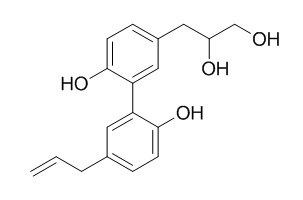Magnolignan A
Magnolignan A-2-O-beta-D-glucopyranoside has medium cytotoxic activity against HEp-2 and HepG2 cells, with IC(50) of 13.3 microM, and 46.4 microM, respectively.
Inquire / Order:
manager@chemfaces.com
Technical Inquiries:
service@chemfaces.com
Tel:
+86-27-84237783
Fax:
+86-27-84254680
Address:
1 Building, No. 83, CheCheng Rd., Wuhan Economic and Technological Development Zone, Wuhan, Hubei 430056, PRC
Providing storage is as stated on the product vial and the vial is kept tightly sealed, the product can be stored for up to
24 months(2-8C).
Wherever possible, you should prepare and use solutions on the same day. However, if you need to make up stock solutions in advance, we recommend that you store the solution as aliquots in tightly sealed vials at -20C. Generally, these will be useable for up to two weeks. Before use, and prior to opening the vial we recommend that you allow your product to equilibrate to room temperature for at least 1 hour.
Need more advice on solubility, usage and handling? Please email to: service@chemfaces.com
The packaging of the product may have turned upside down during transportation, resulting in the natural compounds adhering to the neck or cap of the vial. take the vial out of its packaging and gently shake to let the compounds fall to the bottom of the vial. for liquid products, centrifuge at 200-500 RPM to gather the liquid at the bottom of the vial. try to avoid loss or contamination during handling.
Nutrients.2018, 10(12)
Life (Basel).2021, 11(7):616.
Evid Based Complement Alternat Med.2021, 8707280.
Int J Mol Sci.2020, 21(22):8816.
FEMS Microbiol Lett.2017, 364(11)
Food Science and Biotechnology2015, 2205-2212
Antioxidants.2022, 11(4), 67.
Nutrients.2023, 15(6):1417.
Viruses.2024, 16(7):1128.
Drug Chem Toxicol.2024,1-12.
Related and Featured Products
Magn Reson Chem. 2008 May;46(5):497-500.
1H and 13C NMR assignments for two lignans from the heartwood of Streblus asper.[Pubmed:
18297743 ]
METHODS AND RESULTS:
In our ongoing investigation of the bioactive constituents from plants, two new lignans, Magnolignan A-2-O-beta-D-glucopyranoside and strebluslignanol were isolated from heartwood of Streblus asper, along with three known lignans, Magnolignan A, magnolol, and magnaldehyde D. 1D and 2D NMR experiments, including COSY, HMQC, and HMBC, and other spectroscopic methods, including UV, IR, and MS were used for the determination of the structures and NMR assignments.
CONCLUSIONS:
Primary bioassays showed that Magnolignan A-2-O-beta-D-glucopyranoside and strebluslignanol have medium cytotoxic activity against HEp-2 and HepG2 cells, with IC(50) of 13.3 microM, 46.4 microM and 10.1 microM, 21.7 microM, respectively.
Natural Medicines, 1999 , 53 :1-4.
The simple method of distinction between Japanese and Chinese magnolia bark by ion-pair high-performance liquid chromatography using photodiode array detector[Reference:
WebLink]
To establish a simple method for making distinction between Japanese and Chinese magnolia barks, the components in both magnolia barks were analysed by ion-pair high performance liquid chromatography using a photodiode array detector. Methyleugenol and Magnolignan A were detected only in Chinese magnolia barks. The presence or absence, of these components distinguishes Japanese magnolia barks from Chinese magnolia barks. The amounts these components in Chinese magnolia barks were determined.



